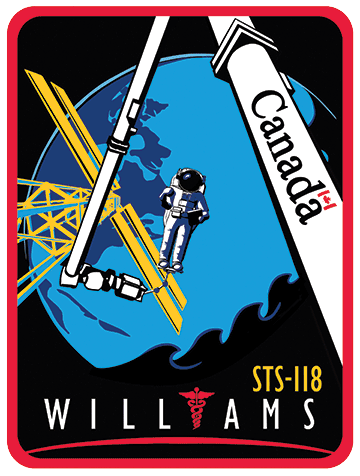Mission STS-118

Mission description

Text version
This patch celebrates Canada's role in STS-118, the 22nd assembly mission of the International Space Station (ISS). It depicts Canadian Space Agency (ASC) astronaut Dr. Dave Williams installing the S5 truss segment to the backbone of the ISS. It marks his role as the only Canadian to perform three spacewalks in support of a human space mission.
The Station's stylized solar arrays symbolize an infinite quest for knowledge through exploration. The inclusion of waves in the design, an ancient symbol of exploration, draws attention to the history of sea and space discovery while highlighting Dr. Williams' experience as the first Canadian to be both an astronaut and an aquanaut.
The STS-118 appears just above the MS in WILLIAMS to underscore his role as Mission Specialist. The caduceus, symbolizing medicine, appearing in Dr. Williams' name represents his pride in being a physician and his role as crew medical officer during the flight. This Canadian emblem was designed by Mustapha Kerouch, a Faculty of Engineering student at McGill University in Montreal.
Patch STS-118. (Credit: Canadian Space Agency)
Launch
Date: August 8, 2007
Time: 6:36 p.m. (ET)
Landing
Date: August 21, 2007
Time: 12:33 p.m. (ET)
Site: Kennedy Space Center
Mission duration: 12 days 17 h 55 min
Orbiter vehicle: Endeavour
Flight number: STS-118
Mission STS-118 launched on . It marked the 22nd shuttle trip to the International Space Station (ISS), and the 20th flight of Space Shuttle Endeavour.
During this mission, astronaut Dave Williams established a Canadian record by spending 17 hours and 47 minutes outside the Space Station during three spacewalks.
The top priority of Mission STS-118 was to deliver and assemble the S5 truss segment to the ISS. Canadarm and Canadarm2 worked hand-in-hand bringing support to the astronauts in building the ISS.
In addition to spacewalking, Dave Williams conducted a Canadian science experiment called Perceptual Motor Deficits in Space (PMDIS), designed to measure astronauts' eye-hand coordination while they are in space. This marked the first time a Canadian performed the test in space.

Mission STS-118 crew
From left to right. Richard A. (Rick) Mastracchio, mission specialist; Barbara R. Morgan, mission specialist; Charles O. Hobaugh, pilot; Scott J. Kelly, commander; Tracy E. Caldwell, Canadian Space Agency's Dafydd R. (Dave) Williams, and Alvin Drew Jr., all mission specialists. (Credit: NASA)